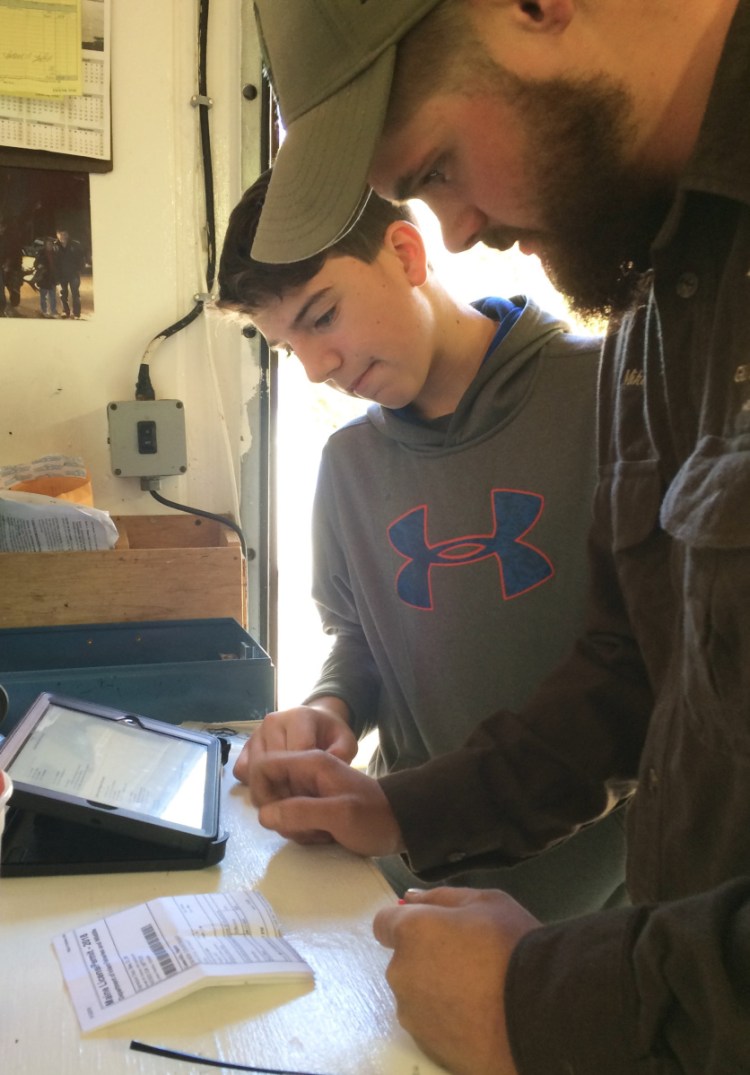ARUNDEL — Growing up in an era when cellphones are as common as hunters in the woods in the fall, Matt Gonneville expected tagging his first deer to be as quick and easy as shooting it.
“I shot it in one hour, 30 minutes,” said Gonneville, 13, after he tagged his 129-pound buck. “I was just sitting on a rock when I heard something and I turned, and waited for it to walk closer. It happened really fast.”
What Gonneville didn’t know was that Maine’s new electronic tagging system, put into place earlier this year, has streamlined the process for hunters. Tagging stations now enter information into a software program that walks them through each piece of data, and allows them to click past fields that are already filled in with personal information via the hunter’s license number.
With the information entered electronically – rather than being written into a book – state biologists can get data about harvests in real time.
On Youth Deer Day last weekend, 1,025 deer were shot across the state. In the past, that data would not have been available for months. Tagging stations used to send the tagging books to the Maine Department of Inland Fisheries and Wildlife at the end of the deer season.
The firearm deer hunt for Maine residents opened Saturday and opens for all hunters Monday. It runs through Nov. 24. It’s followed by muzzleloader season, which lasts from Nov. 26 to Dec. 1.
At LaFlamme’s Custom Meatcutters in Arundel – the state’s largest tagging station – owner Bobby LaFlamme said the transition to the new tagging system has gone smoother than expected.
LaFlamme’s station tags more than 700 deer a year, including 876 last year.
“We bought an iPad just for the tagging,” LaFlamme said. “When the state asked us if we would participate, we said, ‘Absolutely.’ But we don’t want anything to slow us down. So far we’ve tagged a dozen bear, 65 to 70 deer. So far so good. It’s got a good flow. It walks you through it. Everything is in real time.”
There are 285 tagging stations across the state using electronic tagging, said Brittany Peterson, IFW’s electronic registration training manager. Another 27 tagging stations declined to participate, she said. Peterson is still training people at some tagging stations and expects more stations to go electronic in the coming year.
Around the state, tagging stations have reported few issues with the new system.
“It’s very self-explanatory,” Connie Borzykowski, of Valley Brook Variety in Avon, said of electronic tagging. “We like it a lot.”
At Ben’s Trading Post in Presque Isle, assistant manager Josh Boucher said the new system is great for breaking down how many animals they’ve tagged and where they were harvested.
Boucher likes that the tagging software requires an any-deer permit, which allows a hunter to shoot a doe. If the hunter comes in to tag a doe and doesn’t have the permit – a message goes straight to the local game warden, who can investigate immediately.
“It sends all the hunter information, their address, phone number, everything, to the game warden,” Boucher said. “They can take care of it themselves.”
At River’s Edge Sports in Rangeley, owner Gerry White said he was worried at first about the new system, but he said it has been more intuitive than expected.
“I thought it was a good idea right off the bat, but I was definitely worried,” White said. “I thought it would be more complicated than it was. It took very little time to learn it.”
Some tagging stations, however, seem to be struggling to get on board with the new system.
Charlie Frechette, 13, shot his first deer in Sanford on Youth Hunting Day. But when Frechette’s father, Jim, drove them to the nearest tagging station, the woman at the counter of the convenience store didn’t know the password to the software program. The Frechettes had to drive to Springvale Hardware, where more than 100 deer are tagged every fall.
Like LaFlamme’s, the hardware store invested in a new computer for the electronic tagging service.
“We write our password in a book. We are one of the only tagging stations in this area,” said John Larson, a store clerk. “This gets people in the store. But a lot of us are hunters. We like offering the service. We had one hunter this fall come to tag it here all the way from Old Orchard Beach. The store there didn’t have a computer.”
IFW’s Peterson said there has been a limit on how many tagging stations are allowed in a given geographic area because game wardens needed to visit each one. But now that wardens get tagging information online, there is opportunity for multiple tagging stations in a town or area.
“Before there was a limit to how many the wardens could physically visit,” Peterson said. “Now that barrier has been dropped. And it makes sense for high-traffic areas to have more tagging stations.”
Copy the Story LinkSend questions/comments to the editors.




Success. Please wait for the page to reload. If the page does not reload within 5 seconds, please refresh the page.
Enter your email and password to access comments.
Hi, to comment on stories you must . This profile is in addition to your subscription and website login.
Already have a commenting profile? .
Invalid username/password.
Please check your email to confirm and complete your registration.
Only subscribers are eligible to post comments. Please subscribe or login first for digital access. Here’s why.
Use the form below to reset your password. When you've submitted your account email, we will send an email with a reset code.